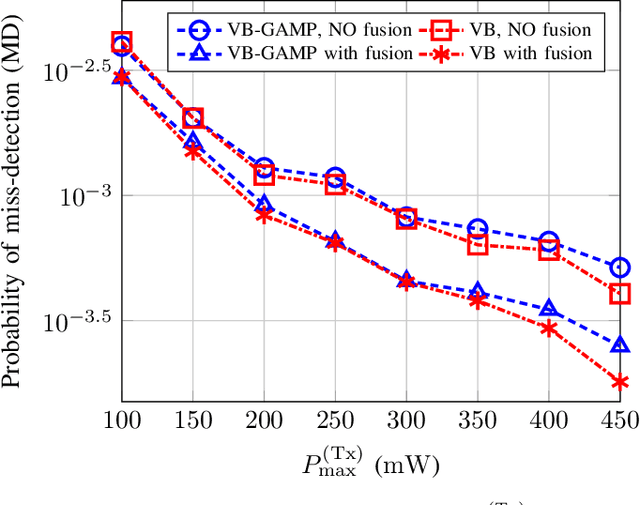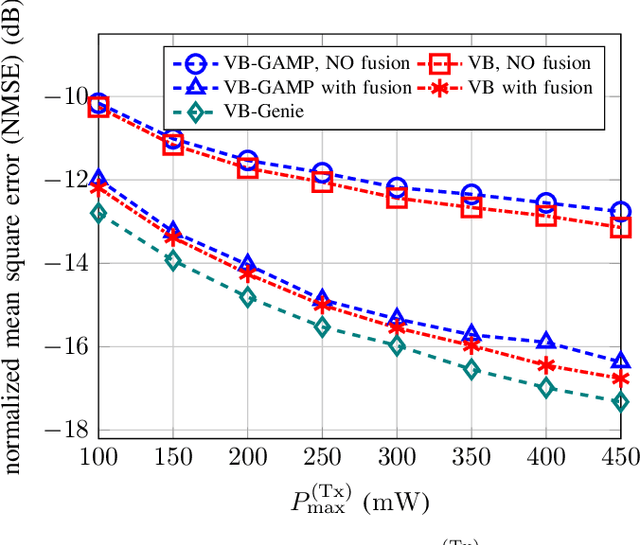Sai Subramanyam Thoota
A Flexible Framework for Grant-Free Random Access in Cell-Free Massive MIMO Systems
Nov 14, 2024

Abstract:We propose a novel generalized framework for grant-free random-access (GFRA) in cell-free massive multiple input multiple-output systems where multiple geographically separated access points (APs) or base stations (BSs) aim to detect sporadically active user-equipment (UEs). Unlike a conventional architecture in which all the active UEs transmit their signature or pilot sequences of equal length, we admit a flexible pilot length for each UE, which also enables a seamless integration into conventional grant-based wireless systems. We formulate the joint UE activity detection and the distributed channel estimation as a sparse support and signal recovery problem, and describe a Bayesian learning procedure to solve it. We develop a scheme to fuse the posterior statistics of the latent variables inferred by each AP to jointly detect the UEs' activities, and utilize them to further refine the channel estimates. In addition, we allude to an interesting point which enables this flexible GFRA framework to encode the information bits from the active UEs. We numerically evaluate the normalized mean square error and the probability of miss-detection performances obtained by the Bayesian algorithm and show that the latent-variable fusion enhances the detection and the channel estimation performances by a large margin. We also benchmark against a genie-aided algorithm which has a prior knowledge of the UEs' activities.
Resource Efficient Over-the-Air Fronthaul Signaling for Uplink Cell-Free Massive MIMO Systems
Nov 14, 2023Abstract:We propose a novel resource efficient analog over-the-air (OTA) computation framework to address the demanding requirements of the uplink (UL) fronthaul between the access points (APs) and the central processing unit (CPU) in cell-free massive multiple-input multiple-output (MIMO) systems. We discuss the drawbacks of the wired and wireless fronthaul solutions, and show that our proposed mechanism is efficient and scalable as the number of APs increases. We present the transmit precoding and two-phase power assignment strategies at the APs to coherently combine the signals OTA in a spectrally efficient manner. We derive the statistics of the APs locally available signals which enable us to to obtain the analytical expressions for the Bayesian and classical estimators of the OTA combined signals. We empirically evaluate the normalized mean square error (NMSE), symbol error rate (SER), and the coded bit error rate (BER) of our developed solution and benchmark against the state-of-the-art wired fronthaul based system
Data-Driven Robust Beamforming for Initial Access
Aug 14, 2023Abstract:We consider a robust beamforming problem where large amount of downlink (DL) channel state information (CSI) data available at a multiple antenna access point (AP) is used to improve the link quality to a user equipment (UE) for beyond-5G and 6G applications such as environment-specific initial access (IA) or wireless power transfer (WPT). As the DL CSI available at the current instant may be imperfect or outdated, we propose a novel scheme which utilizes the (unknown) correlation between the antenna domain and physical domain to localize the possible future UE positions from the historical CSI database. Then, we develop a codebook design procedure to maximize the minimum sum beamforming gain to that localized CSI neighborhood. We also incorporate a UE specific parameter to enlarge the neighborhood to robustify the link further. We adopt an indoor channel model to demonstrate the performance of our solution, and benchmark against a usually optimal (but now sub-optimal due to outdated CSI) maximum ratio transmission (MRT) and a subspace based method.We numerically show that our algorithm outperforms the other methods by a large margin. This shows that customized environment-specific solutions are important to solve many future wireless applications, and we have paved the way to develop further data-driven approaches.
 Add to Chrome
Add to Chrome Add to Firefox
Add to Firefox Add to Edge
Add to Edge